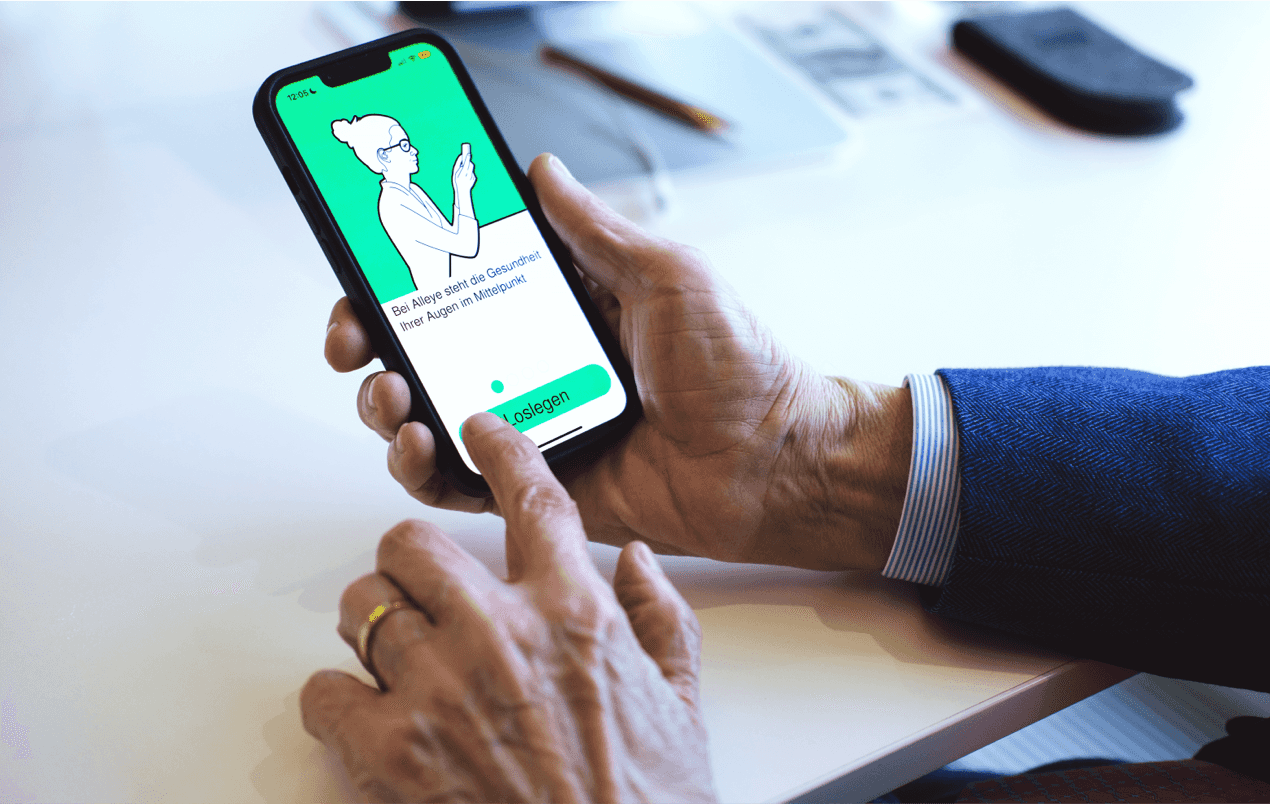ophthalmology in the digital age

Lucas M. Bachmann
Founder / CEO
medignition AG
31.01.2023
With the Alleye app, one can perform a high-quality self-examination of the retina via a smartphone.
Digitalization and new therapeutic options are leading to entirely new possibilities for ophthalmology.
When the Swiss Federal Statistical Office tells us that by 2040 a quarter of the Swiss population will be over 65, we think primarily of financial viability, pension security and, at best, the intergenerational contract. It is often forgotten that this demographic trend also poses major challenges for medicine. Medical disciplines that treat chronic diseases of older people are particularly affected.
Patient growth for ophthalmologists
Hardly any other specialty is affected by this as much as ophthalmology. The typical patient journey with the ophthalmologist begins in the 5th decade of life in connection with presbyopia, examination of eye pressure for early detection of glaucoma or early forms of retinal damage such as age-related macular degeneration. The latter is the most common cause of blindness in old age in Western countries and, accordingly, timely treatment to prevent irreversible vision loss, to ensure autonomy and quality of life of elderly persons is of high importance.
According to simulations, it is estimated that the number of patients requiring treatment for age-related retinal diseases in Switzerland will increase by 50 percent by 2040. This does not include common chronic retinal diseases, which are not yet treatable but will be in the near future due to new drug approvals.
Ophthalmologists practicing today must prepare for a significant increase in patients. In order to counteract the strong increase in volume, measures must be taken to make treatment more efficient, because otherwise there is a risk of a medical care shortage and a loss of treatment quality in Switzerland. The two most important levers to achieve this are on the one hand the prevention of unnecessary ophthalmologist visits and on the other hand pharmacological innovations, which allow longer therapy intervals and thus less frequent ophthalmologist visits.
Self examination with the smartphone
To identify the need for treatment in time, the Swiss technology company Oculocare Medical (a subsidiary of medignition) developed the Alleye product in 2017, which allows to perform a high-quality self-examination of the retina at home using a smartphone. The test detects deterioration of visual function at an early stage, allowing for a timely visit to the doctor and appropriate treatment. The product has been scientifically tested in several studies on thousands of patients.
Among other things, it has been shown that regular home measurement improves long-term visual function, increases adherence to therapy and saves one ophthalmologist check-up per year and patient. The test is approved and used in more than 30 countries worldwide and gained additional popularity especially during the SARS-CoV-2 pandemic, because in many countries the lockdown made regular hospital check-ups impossible. Ophthalmologists felt the need to provide patients with a tool to perform a check-up at home. Thus, those patients who maintained stable visual function could remain at home and those who showed a significant deterioration could be called for a check-up in the practice with increased urgency.
Eye test and more
In addition to the home measurement of visual function, Alleye also allows the recording of administered therapies as well as surveys on well-being or – as propagated, for example, by the central board of the Swiss Medical Association FMH – patient-related endpoints, the so-called patient-reported outcome measures (PROMs). The anonymous evaluation of these data improves the understanding of how patients are actually doing. Today, it is still common practice to uncritically apply the results of controlled, scientific studies, which show an ideal state with regard to the effectiveness of a therapy, to the everyday situation, not to the advantage of patients.
New innovative therapy concepts
Especially for chronic diseases, long-acting drugs are a second important pillar of care efficiency. For the two important retinal diseases, age-related macular degeneration and diabetic macular edema, new innovative therapy concepts have recently become available, which reduce the need for therapy to about half of the current level. The reduced number of office visits does not only relieve the care side, it is also an important relief for the patients themselves and all persons who provide driving services or accompany the patients to the office.
New approaches to care, which have become possible with technologies such as Alleye, have great potential, but are unfortunately still too little used. Digitalization in medicine stirs up many fears regarding data security, loss of privacy and surveillance. First and foremost, it is these fears that have led to a flurry of new regulatory measures in recent years, which significantly restrict the innovative power and implementation of new technologies.
It is necessary that high security standards are required for these technologies. Much more important, however, seems to be the demand that users recognize the benefits of the technologies and are able to profit from their use. In the longer term, only those technologies will be used which have and can demonstrate a significant patient benefit. Accordingly, it is important that these technologies are developed in the closest possible collaboration with those affected. In the case of Alleye, for example, it was precisely this collaboration that showed that even 80-year-old patients who received an introduction were happy to use modern technologies.
Rethinking is necessary
The potential of digital health applications is huge. According to the latest estimates, digitalization of the healthcare system can save up to CHF 8.2 billion in Switzerland. In order for this potential to actually unfold and the desired improvements in healthcare and patient care to be achieved, a change in thinking is still necessary in some places. In addition to good products, structures are also needed to support implementation.
Digitalization programs in the healthcare sector must be specifically promoted, and incentive systems must be created to benefit those patients and physicians who embrace modern care concepts.